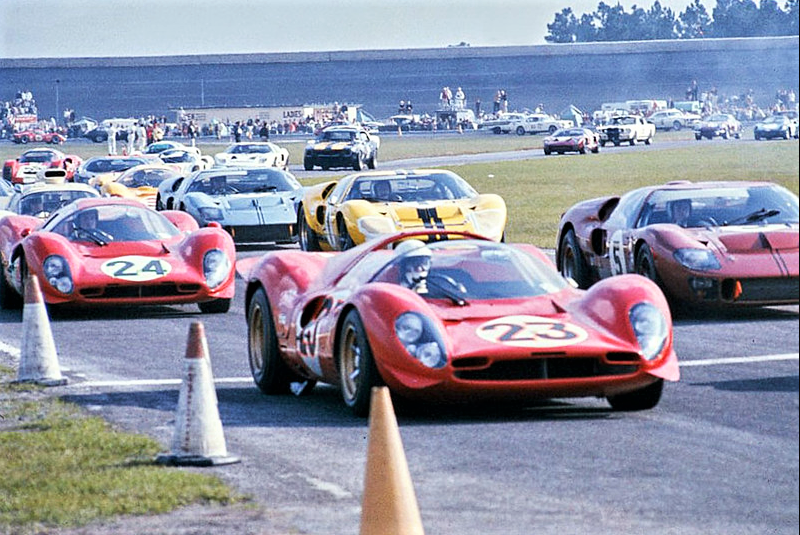Why the 330 P4 was the key in Ferrari’s rivalry with ford?
The 1960s era was the pinnacle of motorsport, with Ferrari rushing to develop 12-cylinder prototypes under the high pressure of its rivals and mainly that of Caroll Shelby (an American automotive designer and racing driver), who was the warhead for Ford's sports-racing program. Later on, the Ferrari 330 P4 was born as a result of this tough competition!
Photo: Ferrari 330 P3 - P4 - 412P
This rivalry started in the 1960s, when Ferrari was the well-known name at Le Mans with their mid-engined P-series of sports cars and their stunning 330 that won titles for them. The 330 P was the first Ferrari to rival a Ford GT40, and when Ferrari and Ford first fought at Le Mans in 1964, the 330 P passed the checkered flag while no Fords finished.
In the 1960s, names such as Porsche, Alfa Romeo, and Ferrari were dominating the racetrack. Henry Ford II was quite ambitious and wanted to show the world what he was capable of in the motorsport field, but he couldn’t do it without finding a shortcut that would boost his presence. The solution for him was to acquire the Italian sports-car maker because of their fame and success at Le Mans, and he was willing to pay millions to Ferrari’s CEO for his company. Enzo Ferrari seemed to accept such a proposal.
Photo: drivetribe.com
The negotiations didn’t go as planned in 1963 when Enzo Ferrari nixed the agreement at the last minute after he noticed a detail in Ford’s contract that stated Ford would take over both Ferrari's racing and automotive divisions. This is when the relationship between the Italian and American automakers deteriorated, and Ford wanted to seek revenge. That’s the story of the movie "Ford vs. Ferrari," which dramatizes the fight between Carroll Shelby's Ford GT40 team and Enzo Ferrari's Scuderia Ferrari for dominance in the world’s most prestigious automotive race, the 24 Hours of Le Mans, which the Prancing Horse has historically dominated. However, the Deuce tried to negotiate with other teams such as Lotus, Lola, and Cooper. The three companies weren’t qualified to enhance Ford’s presence in motorsport, and his only option was to lead an offensive response. That meant beating Ferrari, the biggest name in Le Mans at the time. It was about time for the Los Angeles car designer Carroll Shelby to be responsible for Ford’s failure and success after losing to Ferrari at Le Mans in 1964 and 1965, even after investing around $10 million in its Le Mans program.
Photo: Ferrari 330 P3 - P4 - 412P
Ford’s comeback started in 1966 under the leadership of Shelby, who helped develop the MKII variation and came to Le Mans with their new 7.0-liter Ford GT40 Mk. II, named for its 40-inch height. Although Ferrari and its revised 330 P2 didn’t deliver much racing success in 1965, Ferrari replaced the 330 P2 with the P3 variant in 1966. However, Ford embarrassed and angered Ferrari when they won with a humiliating 1-2-3 finish at both Daytona and Sebring. It was the first time that an American manufacturer had won the prestigious endurance race.
It was time for the most epic showdown in motorsport history. Due to limited resources, Ferrari was able to produce two new fuel-injected 330 P4s to challenge Ford at Daytona in 1967 and one 330 P3/4 running a normally aspirated engine. The 4.2-liter V12, 330 P4, which puts out an estimated 480 bhp, is one of just three P4s ever built and had a nose that was elongated to reduce aerodynamic lift. The 330 P3/4, known as the Ferrari 412P, used a P3 engine mounted within a P4 body.
Photo: pinterest.ie
On the Ford side, the American manufacturer fell out with gearbox troubles that caused the abandonment of five cars, which gave advantages to Ferrari and crossed the finish lines 1, 2, and 3, paying Ford back at the Rolex 24 at Daytona. The No. 23 factory-backed Ferrari 330 P4 driven by Lorenzo Bandini and Amon won the race, followed by their teammates Mike Parkes and Ludovico Scarfiotti in the No. 24 330 P4. The No. 26 Ferrari 330 P3/412P entered by Luigi Chinetti Sr. came home in third place, driven by Pedro Rodriguez and Jean Guichet.
The 1967 season was a landmark for Ferrari, proving to be one of motorsport's most successful manufacturers after rebounding from a disappointing 1966 racing season that saw Ford win a 1-2-3 finish at both the Rolex 24 and the 12 Hours of Sebring, along with a victory at the 24 Hours of Le Mans. The Ferrari 330 P4 was obviously the only car that could bring Ferrari back into the winner’s circle, thanks to its 4-liter V12 engine and key features like wider tires, more genuine wheels, and a 5-speed gearbox. Not to mention the extra 30 horsepower over its predecessor, the P3.





